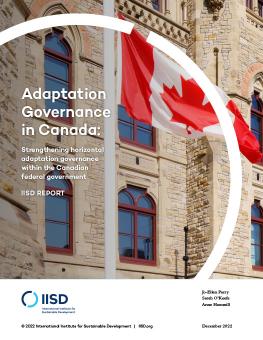
Adaptation Governance in Canada
Strengthening horizontal adaptation governance within the Canadian federal government
The release of Canada's first National Adaptation Strategy (NAS) provides an opportunity to review and revitalize how the federal government coordinates the development and implementation of adaptation policies and programs across departments. As governance systems play a critical role in efforts to adapt to climate change, establishing an effective and efficient federal adaptation governance system will be critical to determining how actors within the federal government come together to collaboratively plan and align adaptation actions.
-
As it begins to implement Canada's first National Adaptation Strategy, the federal government has an opportunity to revitalize its cross-departmental governance structure to better achieve its adaptation goals and objectives.
-
The Intergovernmental Panel on Climate Change stated in its most recent assessment report that strong governance capabilities are a critical enabler of successful adaptation efforts, as they are associated with more ambitious adaptation plans and their effective implementation.
-
Canada can look at the approaches taken by other countries for inspiration when seeking to strengthen governance of climate adaptation across its federal government.
A renewed federal adaptation governance structure will need to clarify institutional roles and responsibilities, establish coordination and knowledge-sharing structures, and formalize accountability mechanisms for measuring and assessing progress. It will need to accommodate departmental differences in mandates, depth of experience in climate adaptation, roles in the adaptation planning process, financing capacities, and relationships with other orders of government. Known factors and characteristics of climate adaptation that make the governance of this issue challenging will need to be addressed, such as limited awareness among senior decision-makers of what adaptation means and involves, ongoing uncertainty regarding the changes to which we are adapting, and a fragmented landscape of actors and priorities.
The report, Adaptation Governance in Canada, outlines options the Government of Canada could consider to augment and strengthen its structures for coordinating climate adaptation policy and programming at the federal level. It draws upon key informant interviews with individuals within and outside of the federal government as well as a review of national-level adaptation governance in other countries. Options are identified for different components of a federal horizontal adaptation governance structure, including its legal mandate, institutional lead, senior- and lower-level coordination structures, knowledge management, and an accountability mechanism.
The paper concludes that the success of any revitalized horizontal adaptation governance system will depend on the extent to which it is supported by the following elements (in reverse order of importance):
- Sufficient funding to ensure that adaptation units within federal departments, as well as any dedicated secretariat or knowledge-brokering unit, have the time and capacity to effectively engage in interdepartmental coordination.
- Awareness of the characteristics of climate change adaptation at senior levels of government, particularly with regard to its unique characteristics and differences when compared to climate mitigation and emergency management.
- Senior-level leadership and its commitment to enhancing the long-term resilience of Canadians to climate change.
Participating experts
You might also be interested in
Border Carbon Adjustments: Trinidad and Tobago country report
This report consolidates, analyzes, and presents views and perspectives of stakeholders from Trinidad and Tobago on border carbon adjustment (BCA) schemes to contribute to the global debate on BCA good practices.
How Can We Work With Nature to Tackle Drought and Desertification?
Drought is one of the most devastating and pervasive challenges exacerbated by climate change. However, we can work to reduce its effects through nature-based solutions for land restoration and climate-smart agriculture.
Climate Negotiations Glossary
Concise definitions of key terms and acronyms used in UNFCCC climate change negotiations and beyond.
Canadian Youth Want to See Stronger Climate Policy in 2024
IISD takes a look at the Canada's Local Conference of Youth demands for policymakers after COP 28.
